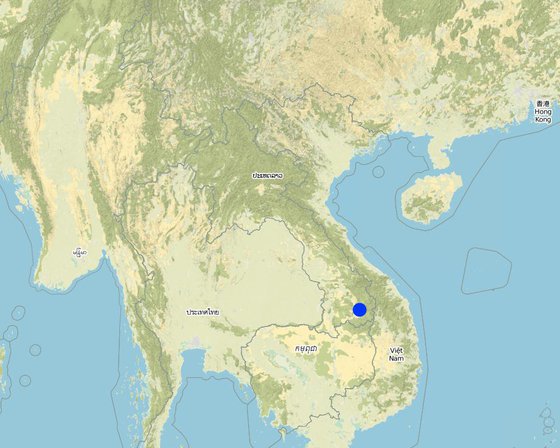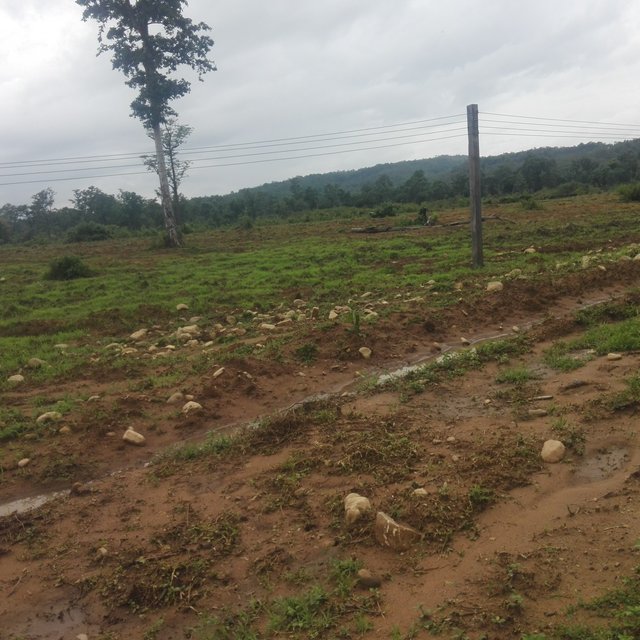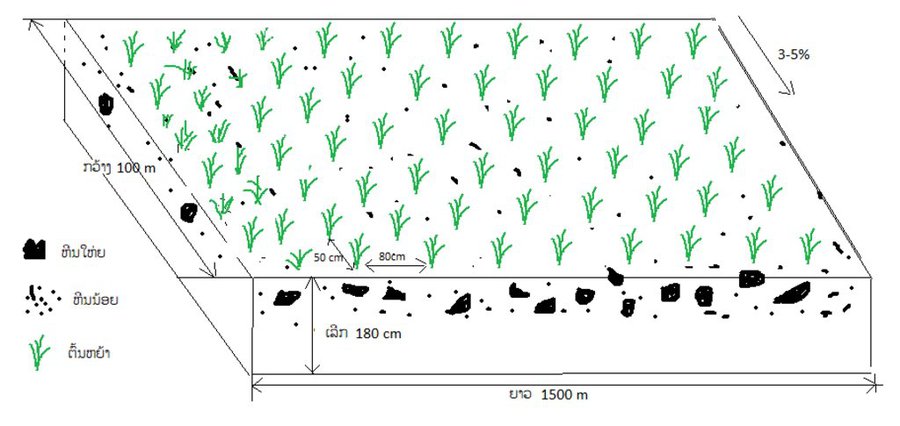



One of the main causes of land degradation in the Tadseng village (Sansay district, Lao PDR) is the flow of storm water that results in sediment run-off which leaves only rocks behind. It is estimated that approximately 20% of clay soils on the top soil have been washed away in recent years. In 2009 The Sustainable National Resources Management Product and Enhancement Project supported by Asia Development Bank (ADB) encouraged villagers to set up cow and forage farms. Ten cow breeding groups were established in the village. The cow farming group had used the communal land with a total 15 ha. After four years of implementation, some group members ignored their responsibilities and the group experienced a number of difficulties in both the management of the livestock and grass, which finally led to the collapse of the system. However, by 2014, one of the former members regained his interest in cow farming. He was able to rent the former 15 ha of land and he re-established the cow farm to a herd of 130 heads. At the beginning he only chose the healthiest stems of grass that remained from the old farm and replanted these. Three grass species were planted in rows on one area, namely Nepir, Guinea and Paspalum. It took thirty days to plow and prepare the land using a tractor and a labour force of more than fifty workers. For about five days, ten of these laborers had to remove the forage roots from the old fields. Generally, mid-May is the most suitable time to plant the grass as there is only a small amount of rain. Work begins by clearing the land and plowing the soil and then leaving it to dry for 15 days in order to get rid of some of the weeds and pests. During this period, some of the organic matter decays and develops into green compost which helps to improve the soil’s structure. This subsequently successfully regenerates the growth of the grass as its roots are able to easily expand throughout the soil. Whilst waiting for the soil to dry fences will be constructed around the plot. Then 40 tons of manure should be transported to the field using a two-wheel tractor. After, the manure has to be distributed and plowed into the soil. At the beginning of June grass can be planted by digging holes in rows, as to place the grass suckers into the ground at a depth of 5 cm. Irrigation is unnecessary as rain is expected in June. Optionally the farmer can use a gravity fed irrigation, if necessary. The forage can be harvested around 90 – 100 days after plantation. There are two options regarding the feeding of livestock: First option involves hired labourers to harvest the grass. The second option is to allow the livestock to graze freely in the field, 6 months after grass plantation. However, this can only be undertaken on a bi-weekly basis so as to allow the grass to regenerate. It is important to extract the weeds and apply organic fertilizer or green manure after the grass has been cut. Maintenance may also involve the repairing of fences. Advantages of this planting grass are the reduction of soil erosion and preventing nutrients from being washed out during heavy rains, as well as reducing soil compaction. Meanwhile the organic matter in the soil increases due to the decay of dead leaves of grass and roots. Further advantage is to grow up stronger and healthier cows. This also means that the farmers get higher household revenue from the sale of his livestock which on average amounts up to 80,000,000Kip/annum. Family members also have more time for other household activities because cows are released in the early morning and called back in late afternoon. However, one of the disadvantages could be a reduction in the local biodiversity such as edible insects and crickets. Furthermore the availability and variety of non-timber forest products declines such as Hed Amanita hemibapha, broom grass and rattan. Wildlife numbers have also reduced as people used to find and squirrels in this region. Another challenge may be that households have limited labour power to maintain fences and the forage fields, as it is relatively expensive to hire workers at 50,000 Kip/day. Difficulties in carrying out weeding include Nga Nam Keo. It should be noted that farmer make significant savings by not having to buy grass seeds as he can collect grass rhizomes from the old farm area.

Location: Tadseng village Sansay district, Attapue province, Lao People's Democratic Republic
No. of Technology sites analysed: single site
Spread of the Technology: evenly spread over an area (approx. 0.1-1 km2)
In a permanently protected area?:
Date of implementation: 2011; less than 10 years ago (recently)
Type of introduction






| Specify input | Unit | Quantity | Costs per Unit (kip) | Total costs per input (kip) | % of costs borne by land users |
| Labour | |||||
| planting labour | person-day | 20.0 | 50000.0 | 1000000.0 | 100.0 |
| fencing labour | person-day | 30.0 | 50000.0 | 1500000.0 | 100.0 |
| fertilizing labour | person | 60.0 | 50000.0 | 3000000.0 | 100.0 |
| Equipment | |||||
| Hummer | piece | 6.0 | 35000.0 | 210000.0 | |
| Draper Fence Wire Tensioning Tool | piece | 3.0 | 170000.0 | 510000.0 | |
| Manure transfer by tractor | trip | 60.0 | 35000.0 | 2100000.0 | |
| Glass packing machine | Machine | 3.0 | 1500000.0 | 4500000.0 | |
| Plant material | |||||
| Paspalum seeds | Kg | 55.0 | 50000.0 | 2750000.0 | |
| Guniea seeds (Megathyrsus maximus) | Kg | 40.0 | 50000.0 | 2000000.0 | |
| Napier seeds (Pennisetum purpureum) | Kg | 35.0 | 50000.0 | 1750000.0 | |
| Fertilizers and biocides | |||||
| Manure | ton | 40.0 | 200000.0 | 8000000.0 | 100.0 |
| Construction material | |||||
| Nail | box | 1.0 | 80000.0 | 80000.0 | |
| Wire | roll | 48.0 | 250000.0 | 12000000.0 | |
| Post hole | hole | 1600.0 | 10000.0 | 16000000.0 | |
| Fence post | piece | 1600.0 | 3000.0 | 4800000.0 | |
| Total costs for establishment of the Technology | 60'200'000.0 | ||||
| Total costs for establishment of the Technology in USD | 7'525.0 | ||||
| Specify input | Unit | Quantity | Costs per Unit (kip) | Total costs per input (kip) | % of costs borne by land users |
| Labour | |||||
| Labor | person-day | 50.0 | 30000.0 | 1500000.0 | 100.0 |
| Equipment | |||||
| Hoe | piece | 25.0 | 30000.0 | 750000.0 | |
| Total costs for maintenance of the Technology | 2'250'000.0 | ||||
| Total costs for maintenance of the Technology in USD | 281.25 | ||||
Previously the soil was mixed with rocks and big stones, so that it was difficult for planting. By applying the grass cultivation method and gradually remove of those stones and rocks crop production is increased.
Before the land user let his animals take up only natural grass from the sourroundings. After, by cultivating different grass varieties in a large area the fodder production increased substantially
Natural grass is low in nutrients and proteins necessary for animal growth compared to the high potential grass varieties planted by the farmer. This grass varieties have many nutrients and proteins required for animal husbandry.
Previously the lack of fodder for animal husbandry resulted in low animal production. From the moment the farmer was able to get enough fodder from his grasslands the animal production increased significantly.
Because limited fodder especially in dry season the animal production failure quit a problem. From the moment he was able to produce high valued animal fodder on a large area the risk of production failure decreased to some extent.
Before the farmer got only natural grass from the surroundings, but now he produce Napir grass, Guinea grass, Paspalum grass by himself.
Before animal husbandry is dependet from natural forests and from rice fields. After the farmer was able to expand the productive area by 15 square metres of grassland.
Before the animal had grazed freely in the village sourroundings and so the farmer had to guard them. After grass cultivation the animals graze on fenced grass lands on a bi-weekly basis. And futher the cattle can be fed by own freh or dried fodder grass.
There enlarged area called for more monetary inputs to establish the cattle farm and to cultivate the additionoal 15 ha (new expenses: cattle housing, fencing, grass varieties and farm maintenance).
Quantity before SLM: None
Quantity after SLM: 80,000,000 kip/annual
The increase in revenues base on the fact, that now the farmer can sell many healty and strong cows every year at a good price. Actually, he produces cows even for the export to Vietnam.
Before cows has been sold in few numbers. After the application of the technology the farmer raises besides of a larger amount of cows also goats, pigs, poultry for the market. In addition he can sell different grass seed varieties.
Previously the animal raising based on free grazing in the village sourroundings. The establishment and maintenance of the new grassland area and the increased cow herd and other livestock resulted in increased workload.
The soil cover increased significantly because of the cultivation ot the strong and expansive grass varieties.
The soil can be fixed by the expanding and deep roots of the different grass varieties. Furhtermore, grass residues promote better soil cover that reduces soil loss by water erosion too.
During the rainy season the plant detritus and manure promote soil accumulation.
The expanding and deep root system of the grass cultivation improves the soil structure significantly.